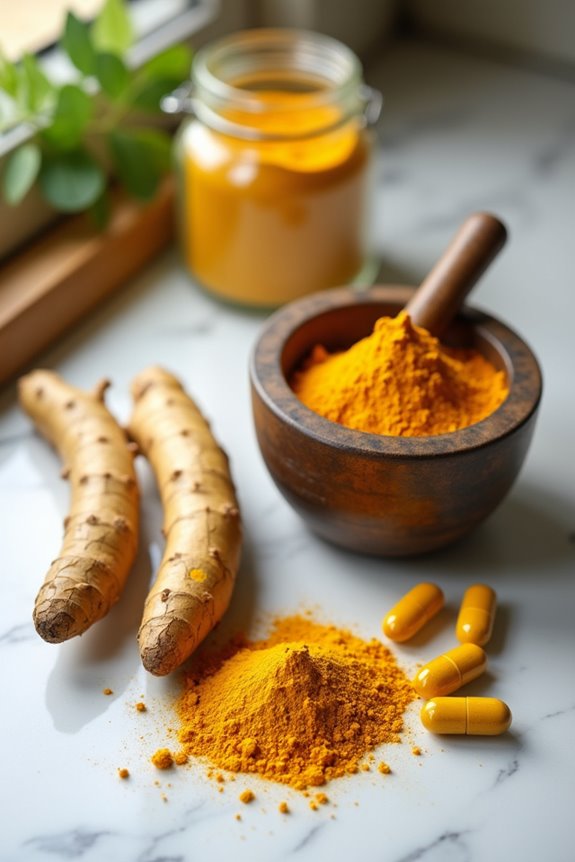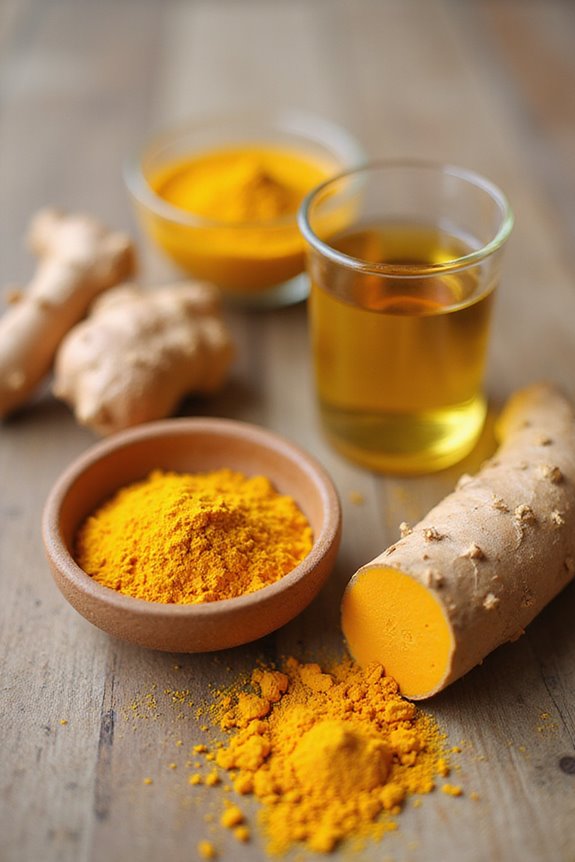Turmeric (*Curcuma longa*) is a flowering plant native to India and Indonesia, recognized for its yellow pigment and culinary use. Curcumin is its principal active compound, known for anti-inflammatory benefits and potential cognitive enhancement. Research suggests curcumin influences inflammatory pathways and may improve memory functions. While generally safe, it faces bioavailability challenges affecting its efficacy. Innovative delivery systems are being developed to address this limitation. Additional insights into turmeric and curcumin’s applications await further exploration.
Key Takeaways
- Turmeric is a flowering plant known for its active compound, curcumin, which has various health benefits, including anti-inflammatory properties.
- Curcumin may enhance cognitive function and memory, with some studies showing improvements in working memory in older adults.
- Curcumin’s bioavailability is low, making it essential to explore innovative delivery methods and combinations to improve absorption and therapeutic effects.
- Common doses of curcumin around 1,000 mg per day are generally safe, with mild digestive issues possible at higher amounts.
- Ongoing research aims to identify biomarkers for curcumin effectiveness, facilitating personalized treatment plans based on individual responses.
What Is Turmeric and Where Does It Come From?
Turmeric, scientifically known as *Curcuma longa*, is a flowering plant belonging to the ginger family.
Turmeric Origins
- Native to Southern India and Indonesia.
- Cultivated for over 4,000 years, primarily in India.
Turmeric Cultivation
- India is the largest producer and exporter of turmeric globally.
- The plant thrives in tropical climates with well-drained soil and ample rainfall.
- Historically significant, turmeric was utilized in ancient civilizations, including the Indus Valley.
Cultural Significance
- Holds immense importance in Hindu rituals, symbolizing purity and auspiciousness.
- Used in various culinary applications, it adds both flavor and color.
Through centuries of cultivation and cultural relevance, turmeric has established itself as an essential component in both traditional and modern practices.
What Is Curcumin and How Is It Related to Turmeric?

- Chemical Composition: Curcumin’s molecular formula is C21H20O6, and it belongs to the diarylheptanoids chemical group.
- Cultivation Techniques: Turmeric cultivation techniques impact curcumin yields, influencing extraction methods used in industries.
Curcumin is recognized for its yellow color and is utilized as a colorant, flavorant, and herbal supplement. Despite its popularity, curcumin faces challenges in bioavailability and stability, affecting its therapeutic applications.
What Are the Health Benefits of Turmeric and Curcumin?

What specific health benefits can be attributed to turmeric and curcumin? Turmeric and its active compound, curcumin, offer numerous health advantages:
- Antioxidant Properties: They combat oxidative stress in the body.
- Heart Health: Turmeric may reduce inflammation and improve cholesterol levels.
- Cognitive Function: Curcumin has been linked to improved memory and may slow neurocognitive decline.
- Mood Enhancement: Turmeric may alleviate symptoms of depression.
- Diverse Applications: Used for wound healing, allergies, and asthma management.
For effective results, individuals often turn to turmeric supplements, which can deliver concentrated curcumin dosage. This approach can enhance the associated health benefits, making turmeric and curcumin important components of a balanced health regimen.
How Does Curcumin Help With Inflammation and Pain?

Curcumin, the active compound found in turmeric, is recognized for its potent anti-inflammatory properties, which can greatly impact conditions characterized by inflammation and pain.
Curcumin Mechanisms
- Curcumin modulates key inflammatory pathways, including NF-κB, MAPK, and AP-1, which are essential in regulating inflammation.
- It down-regulates NF-κB through PPARγ activation, reducing pro-inflammatory gene expression.
- Additionally, curcumin inhibits the NLRP3 inflammasome assembly, decreasing the release of inflammatory cytokines like IL-1β.
Impact on Inflammatory Mediators
- Curcumin suppresses inflammatory cytokines, including TNF-α, and reduces neutrophil activation.
- Its interaction with PPAR-γ further diminishes cytokine release, contributing to tissue protection during inflammatory responses.
This evidence highlights curcumin’s potential clinical applications in managing inflammation and pain.
Can Turmeric and Curcumin Improve Cognitive Function?

Can turmeric and curcumin truly enhance cognitive function? Research indicates that curcumin supplementation may offer significant cognitive benefits, particularly in working memory and attention. Key findings include:
- Working memory improvement: Moderate effect size (Hedges’ g = 0.396) compared to placebo in randomized controlled trials.
- Processing speed: Borderline improvements (Hedges’ g = 0.303), necessitating further research.
- Memory tests: 28% enhancement observed over 18 months in older adults.
- Cognitive stabilization: Potential to prevent decline in mild cognitive impairment and healthy aging.
Curcumin’s antioxidant and anti-inflammatory properties may counteract neuroinflammation, supporting cognitive enhancement. Enhanced blood flow to the brain and reduced amyloid accumulation further substantiate its role in cognitive function. Overall, curcumin supplementation presents promising avenues for cognitive health.
What Are the Safety and Side Effects of Using Curcumin?
Safety and side effects associated with curcumin use warrant careful consideration, particularly given its widespread popularity as a dietary supplement.
Established Safety
- Curcumin has a well-established safety record, with an allowable daily intake (ADI) of 0–3 mg/kg body weight.
- Common doses around 1,000 mg per day typically do not lead to adverse effects.
Potential Side Effects
- Mild digestive issues, headaches, and nausea may occur, especially at doses exceeding 500 mg.
- Rarely, skin rash and yellow stool have been reported.
Drug Interactions
– Curcumin can interact with medications, necessitating consultation with healthcare professionals.
Rare Adverse Effects
– Reports of liver injury, albeit rare, have been documented, prompting ongoing investigations into curcumin safety assessments.
How Can I Enhance the Bioavailability of Curcumin?
How can the bioavailability of curcumin be enhanced? Several bioavailability strategies exist to improve curcumin absorption:
- Particle Size Reduction: Smaller particles increase surface area, enhancing solubility.
- Surfactants and Carriers: These improve curcumin dispersibility in formulations.
- Inclusion Complexes: Cyclodextrins can enhance both solubility and stability.
- Nanoparticles: PLGA and biopolymer nanoparticles markedly improve bioavailability.
- Piperine Addition: This compound from black pepper boosts curcumin absorption.
Further advancements include:
- Nanoemulsions: Enhance solubility and stability.
- Food-Grade Ingredients: These formulations have shown improved efficacy in clinical trials.
- Lipid-Based Systems: They enhance curcumin absorption.
Continued exploration of these strategies is essential for optimizing curcumin’s therapeutic potential.
What Are the Best Forms of Turmeric and Curcumin to Take?
Determining the best forms of turmeric and curcumin to take requires an understanding of various supplement options available on the market.
Common Forms:
- Liquid Extracts: Ideal for those who prefer to avoid pills, these can easily be mixed into beverages or foods.
- Softgel Forms: Often combined with absorption enhancers like black pepper extract, these improve bioavailability considerably.
Other Options:
- Capsules/Tablets: Standardized to high curcuminoid content, they are the most common.
- Gummies: While convenient, they typically contain lower curcumin doses.
- Powders: A natural choice, though they may present absorption challenges.
Key Considerations:
– Look for formulations with standardized extracts, specifically 95% curcuminoids, to maximize effectiveness.
What Does Future Research Hold for Turmeric and Curcumin?
Future research on turmeric and curcumin is poised to explore various aspects of their pharmacological potential, particularly through rigorous scientific methodologies.
Clinical Trials Expansion
- Increased global clinical trials will focus on curcumin’s anti-inflammatory and antioxidant properties.
- High-quality systematic reviews and meta-analyses will clarify supported health benefits and develop clinical guidelines.
Chronic Disease and Cancer Prevention****
- Investigations into curcumin’s role in chronic inflammation and cancer prevention are anticipated.
- Exploration of ideal dosing and combination therapies will enhance efficacy.
Advanced Mechanistic Investigations
- Next-gen curcumin research will utilize multi-omics approaches to uncover molecular mechanisms.
- Identifying biomarkers for responsiveness will be prioritized.
Novel Delivery Systems
– Innovations will aim to improve curcumin bioavailability through advanced formulations and nanotechnology.
Frequently Asked Questions
Can I Use Turmeric in Cooking for Health Benefits?
Turmeric can be beneficial in cooking, enhancing health through various recipes. Utilizing cooking methods like frying in oil or adding black pepper can optimize curcumin absorption, allowing individuals to enjoy flavorful dishes while promoting wellness.
Are There Any Specific Diets That Recommend Turmeric?
In the culinary garden, turmeric blooms brightly, symbolizing health. Various diets, such as Ayurvedic and Mediterranean, embrace turmeric supplements and turmeric recipes, weaving its vibrant essence into daily meals for wellness and community connection.
How Long Does It Take to See Benefits From Curcumin?
Curcumin absorption varies, with benefits typically observed after more than eight weeks of consistent turmeric dosage. Long-term supplementation, particularly at doses around 800 mg daily, is essential for significant improvements in inflammation and cognitive function.
Is Turmeric Safe for Children to Consume?
Turmeric, while often safe in dietary amounts, poses risks for children—especially regarding lead contamination. Turmeric dosage guidelines remain unclear, and turmeric allergy concerns necessitate medical supervision when considering supplements for young ones.
Can Turmeric Stain Teeth or Skin?
Turmeric can stain teeth and skin due to its curcumin content. To mitigate staining, individuals should practice good oral hygiene and take skin precautions, ensuring careful handling to prevent unwanted discoloration during use.





